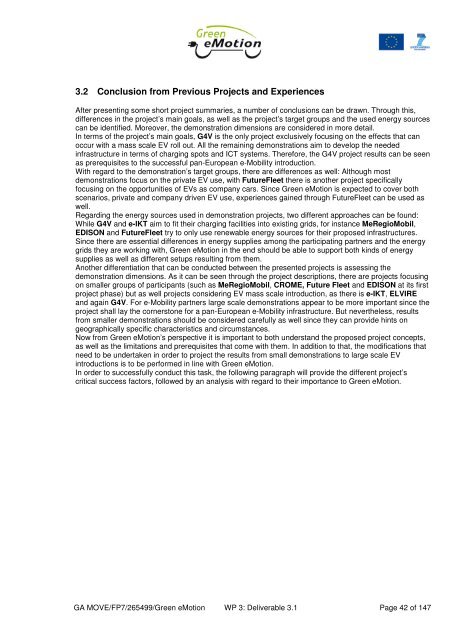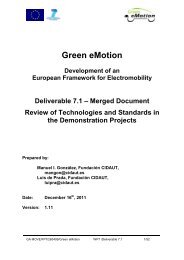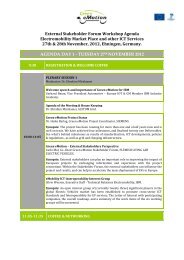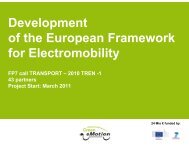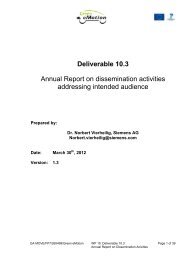Deliverable 3.1 Business Analysis - Green eMotion Project
Deliverable 3.1 Business Analysis - Green eMotion Project
Deliverable 3.1 Business Analysis - Green eMotion Project
Create successful ePaper yourself
Turn your PDF publications into a flip-book with our unique Google optimized e-Paper software.
3.2 Conclusion from Previous <strong>Project</strong>s and Experiences<br />
After presenting some short project summaries, a number of conclusions can be drawn. Through this,<br />
differences in the project’s main goals, as well as the project’s target groups and the used energy sources<br />
can be identified. Moreover, the demonstration dimensions are considered in more detail.<br />
In terms of the project’s main goals, G4V is the only project exclusively focusing on the effects that can<br />
occur with a mass scale EV roll out. All the remaining demonstrations aim to develop the needed<br />
infrastructure in terms of charging spots and ICT systems. Therefore, the G4V project results can be seen<br />
as prerequisites to the successful pan-European e-Mobility introduction.<br />
With regard to the demonstration’s target groups, there are differences as well: Although most<br />
demonstrations focus on the private EV use, with FutureFleet there is another project specifically<br />
focusing on the opportunities of EVs as company cars. Since <strong>Green</strong> <strong>eMotion</strong> is expected to cover both<br />
scenarios, private and company driven EV use, experiences gained through FutureFleet can be used as<br />
well.<br />
Regarding the energy sources used in demonstration projects, two different approaches can be found:<br />
While G4V and e-IKT aim to fit their charging facilities into existing grids, for instance MeRegioMobil,<br />
EDISON and FutureFleet try to only use renewable energy sources for their proposed infrastructures.<br />
Since there are essential differences in energy supplies among the participating partners and the energy<br />
grids they are working with, <strong>Green</strong> <strong>eMotion</strong> in the end should be able to support both kinds of energy<br />
supplies as well as different setups resulting from them.<br />
Another differentiation that can be conducted between the presented projects is assessing the<br />
demonstration dimensions. As it can be seen through the project descriptions, there are projects focusing<br />
on smaller groups of participants (such as MeRegioMobil, CROME, Future Fleet and EDISON at its first<br />
project phase) but as well projects considering EV mass scale introduction, as there is e-IKT, ELVIRE<br />
and again G4V. For e-Mobility partners large scale demonstrations appear to be more important since the<br />
project shall lay the cornerstone for a pan-European e-Mobility infrastructure. But nevertheless, results<br />
from smaller demonstrations should be considered carefully as well since they can provide hints on<br />
geographically specific characteristics and circumstances.<br />
Now from <strong>Green</strong> <strong>eMotion</strong>’s perspective it is important to both understand the proposed project concepts,<br />
as well as the limitations and prerequisites that come with them. In addition to that, the modifications that<br />
need to be undertaken in order to project the results from small demonstrations to large scale EV<br />
introductions is to be performed in line with <strong>Green</strong> <strong>eMotion</strong>.<br />
In order to successfully conduct this task, the following paragraph will provide the different project’s<br />
critical success factors, followed by an analysis with regard to their importance to <strong>Green</strong> <strong>eMotion</strong>.<br />
GA MOVE/FP7/265499/<strong>Green</strong> <strong>eMotion</strong> WP 3: <strong>Deliverable</strong> <strong>3.1</strong> Page 42 of 147


